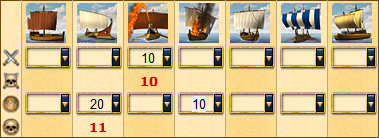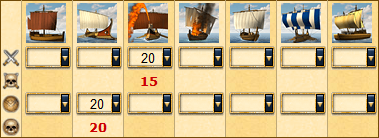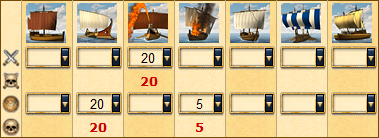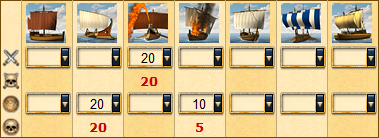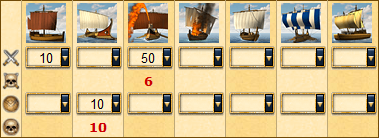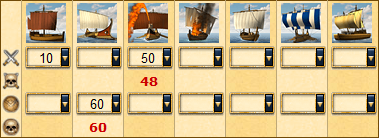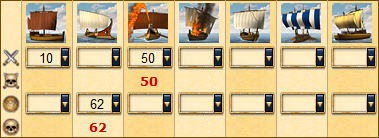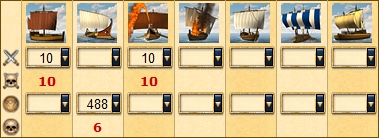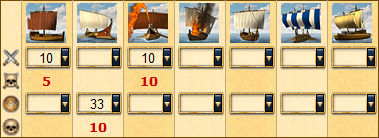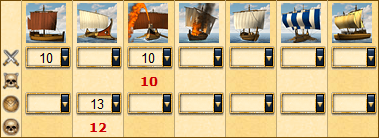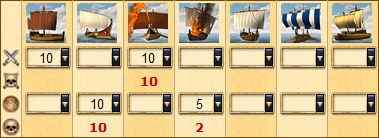Guide:Naval Combat Guide
 | Please Note This is a guide written by Malevolent for the .EN forums. Introduction from the Author: |
Basics:
Each ship has an attack value and a defence value. This will tells you how much value it adds to the combat depending on what you are using it for. For example, a light ship has an attack value of 200 and a defense value of 60. Obviously this ship is designed to be used in attacking the enemy, not defending from them. A Trireme however has an attack of 180 and a defense of 250. Although this ship is better at defending than attacking, it can be used for both should it need to be.
Actual attack example 1:
This was an actual attack and those of you who regularly read the forums will have found this report in another thread. There was a long debate on how it was unfair that an attacker had won the combat, although there was also a ground battle involved, what interests us is the naval battle. Figures where thrown around, ideas, conspiracies about the premium feature and in the end we managed to stumble across how to the simulator decided on the amount of ships that survived the main combat.
The naval part of the report is below. As can be seen, 1 transport ship was destroyed and so were all light ships with it; the defender lost all but 2 Biremes and 1 trireme. As will be mentioned, transports don't get involved in combat so the defenders transports were left untouched.
 The main thing that needs to be noted in this combat is the luck of the attacker. Most people say that luck doesn't have a great deal to play in the battle but it really does. As you will see, luck doesn't just affect the damage that each ship will do, it affects how the premium bonus affect and the tech research.
The main thing that needs to be noted in this combat is the luck of the attacker. Most people say that luck doesn't have a great deal to play in the battle but it really does. As you will see, luck doesn't just affect the damage that each ship will do, it affects how the premium bonus affect and the tech research.
Attacker:
| Ship/Bonus | Attack Value | Quantity | Total |
|---|---|---|---|
| Light Ship | 200 | 10 | 2000 |
Defender:
| Ship/Bonus | Attack Value | Quantity | Total |
|---|---|---|---|
| Bireme | 160 | 17 | 2720 |
| Trireme | 250 | 3 | 750 |
| Light Ship | 60 | 2 | 120 |
| 3590 |
Now what needs to be remembered is that the attacker doesn't just have ships, they have luck, tech and premium abilities that will affect the way that their troops fight. For this report, it was proved that the defender had none of these abilities where as the attacker had the Captain, a premium ability. Whilst this may seem unfair, its a part of the game and it will be included in this combat because it is. I will then run simulations without them as proof that they have a major impact.
Working out each individually and getting an overall result for the attackers value and defenders value we can see how much the defender actually wins by.
Attacker:
| Ship/Bonus | Attack Value | Quantity | luck | Total |
|---|---|---|---|---|
| Light Ship | 200 | 10 | 560 | 2560 |
| Captain | 20% | 400 | 112 | 512 |
| 3072 |
Defender:
| Ship/Bonus | Attack Value | Quantity | Total |
|---|---|---|---|
| Bireme | 160 | 17 | 2720 |
| Trireme | 250 | 3 | 750 |
| Light Ship | 60 | 2 | 120 |
| 3590 |
The attacker has an overall score of 3072
The defender has an overall score of 3590
We can see from the two results that the defender has a greater score and therefore would win the combat. The report above proves that the defender would win the combat. Unfortunately it would take a great deal of time and effort to figure out just which ships would survive the attack and which would be killer. So I won't even try that at the moment.
Simulated attack example 1:
This simulated attack is without using the premium ability that the player had at his disposal. As you can see from the simulated result below. The attacking player takes greater hits.
Using the same manual method as before, but skiping directly to the last two tables, we can see that the attacker would clearly lose the sea battle and therefore take heavier losses. This shows just what a difference having the premium ability can actually make.
Attacker:
| Ship/Bonus | Attack Value | Quantity | luck | Total |
|---|---|---|---|---|
| Light Ship | 200 | 10 | 560 | 2560 |
| 2560 |
Defender:
| Ship/Bonus | Attack Value | Quantity | Total |
|---|---|---|---|
| Bireme | 160 | 17 | 2720 |
| Trireme | 250 | 3 | 750 |
| Light Ship | 60 | 2 | 120 |
| 3590 |
Simulated attack example 2:
The simulated attack in this case shows the attacker without any help. No luck, no premium features. We can see what the difference from the first two attacks are.
Again, using the manual method of working out attack and defence we can find out the values that each combatant went to war with.
Attacker:
| Ship/Bonus | Attack Value | Quantity | Total |
|---|---|---|---|
| Light Ship | 200 | 10 | 2000 |
Defender:
| Ship/Bonus | Attack Value | Quantity | Total |
|---|---|---|---|
| Bireme | 160 | 17 | 2720 |
| Trireme | 250 | 3 | 750 |
| Light Ship | 60 | 2 | 120 |
| 3590 |
- However, fire ships and transports are an exception to normal combat.
Fire Ships
Fire ships are special in that they don't add to the attack value during the first round of combat. The image below shows a naval combat between 10 light ships (attacking) and 20 Biremes (defending). The defender also has 10 fire ships.
As can be seen from this image, 11 of the Biremes are destroyed whilst defending and none of the fire ships are hurt. If we increase the amount of light ships attacking until they are win, the fire ships will then kill some. First you will be shown the results without the fire ships included in the equation.
The next image shows when 5 fire ships are added to the simulator. As you can see they destroy the remaining light ships that have survived after the first round of combat.
This final image for fire ships has an extra number of fire ships. As can be seen, the only fire ships lost are the ones that took out the remaining attackers ships. The exact number of attackers ships that remained after the first round of combat was 5. 5 out of 10 fire ships are destroy as each fire ship will take 1 ship with it.
Transports
Transports don't act the way that normal ships do. They don't get involved in combat and as such their stats don't count towards anything. Using a report and simulations I will demonstrate how the amount of transport ships that make it to shore is worked out.
Attacker Win
Attacker win example 1:
In this example, the attacker will beat the defenders navy by a large margin. Transport ships will be included in the calculation and you will see that none of the transport ships are damaged in this example. This shows that to win by a large majority is to get all your land units to safety without the loss of any transport ships.
Attacker win example 2:
In this example, the attacker will still beat the defender, however he will only beat the defender by a very narrow margin, say one or two ships survive.
Attacker win example 3:
This example shows that all the attackers ships have been destroyed, but so have the defenders. It shows that no matter what, if all the defenders ships are destroyed then all the transports will make it safely to the shores to attack the city.
Defender Win
Defender win example 1:
In this example, the defender will beat the attacker by a large margin. None of the transports will survive the attack and so none of the troops on the ground will make it to the city.
The number of Biremes required to kill all 10 transport ships is a hell of a lot. The number there is the minimum amount required for the defender to kill all 10 transport ships attacking him.
Defender win example 2:
The defender in this example will kill about 50% of the transports that are attacking including the attackers fleet. It won't require nearly as many ships as were required to kill off all 10 transports like the last example.
The number of Biremes in this example is also the amount of ships that were exactly required to kill 50% of the attacking transports. It is not even 1/10 of what was needed to kill off all 10 transports like defender winning example 1.
Defender win example 3:
The defender will win this battle with a single Bireme surviving the attack. You will see that although a Bireme has survived, none of the transport ships have been damaged in the attack and all have made it to their destination on the shore and are attacking the city.
In the next example I will throw in fire ships. The attacker will win the first round of combat, but the fire ships will be enough to destroy the remaining ships with a few left over. Let's see what happens.
As can be seen from the results, the attackers fleet is destroyed but the transports still survive. Surely some of them must have been killed by the fire ships? Actually, the fire ships take part in combat after the main battle because they are so slow. The transports are well out of harms way and already unloading their troops by the time the fire ships join combat and as such they can only affect normal ships.



